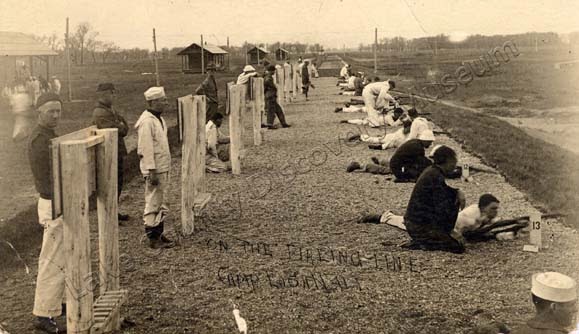John Alexander Logan, namesake of Camp Logan, Zion.
Congressional Portrait Collection, Library of Congress
The camp was named for General John Alexander Logan, a politician who raised and commanded the 31st Illinois Volunteer Regiment from southern Illinois
The camp was located east of Sheridan Road and adjacent to the Chicago & Northwestern Railroad line. It was purchased by the state legislature in 1892 to facilitate National Guard training in the region.
The camp was located east of Sheridan Road and adjacent to the Chicago & Northwestern Railroad line. It was purchased by the state legislature in 1892 to facilitate National Guard training in the region.
Camp Logan, circa 1900. Private collection.
By 1900, the camp was well established and included a headquarters office, four regimental barracks, range office, mess hall, kitchen and arsenal. From an early date, regular Army marksmen from Fort Sheridan preferred the rifle range at Camp Logan
Before World War I, the Illinois National Guard put great emphasis on rifle marksmanship. It was one of the few Guard activities that was judged by strict Army regulations.
Training at the camp included handling of small weapons, tactical maneuvers, and rifle marksmanship. Soldiers performed a variety of marksmanship scenarios on targets located from 100 to 1,000 yards oriented towardLake Michigan . In 1902, over 6,000 soldiers attended the camp and expended over 640,000 rounds of ammunition.
Two key innovations were incorporated into the Camp Logan range, the echelon target system and Aiken targets. For more on the inventor of the Aiken targets, see my post on Illinois National Guardsman, Robert Aiken.
Firing line, Camp Logan. Date unknown.
The camp's arsenal is visible in the background at right.
Private collection.
U.S. Naval rifle range, Camp Logan. Date unknown. Private collection.
Before World War I, the Illinois National Guard put great emphasis on rifle marksmanship. It was one of the few Guard activities that was judged by strict Army regulations.
Training at the camp included handling of small weapons, tactical maneuvers, and rifle marksmanship. Soldiers performed a variety of marksmanship scenarios on targets located from 100 to 1,000 yards oriented toward
Two key innovations were incorporated into the Camp Logan range, the echelon target system and Aiken targets. For more on the inventor of the Aiken targets, see my post on Illinois National Guardsman, Robert Aiken.
Corp. Rex Coniglio, Lieut. D.E. Zealand, and Private M. Cherion
using 3-inch trench mortar at Camp Logan.
Circa 1937. (LCDM 2013.18.28)
From 1933 to 1937, Colonel George Marshall was assigned as the senior instructor at the camp. Marshall would become U.S. Secretary of State in 1947 and thereafter develop the Marshall Plan for the economic recovery of Europe after World War II.
After World War II, training became more restrictive due to the development of more powerful weapons and the increasing civilian population around the camp. The camp’s use dwindled until it was closed in 1974.
View of some of the buildings, and more construction underway at Camp Logan.
Circa 1918. (LCDM 99.7.6)
In 2000, the 243-acre Camp Logan National Guard Rifle Range Historic District, including the remaining 1890s - 1950s buildings and landscape structures were listed on the National Register of Historic Places. Camp Logan was placed on the list because of its status as the best remaining example of a pre-World War II National Guard training facility in Illinois and the role it played in the evolution of the Illinois National Guard.
One of the remaining structures at the Camp Logan National Guard Rifle Range Historic District.
Photo courtesy of the Illinois Department of Natural Resources.





















